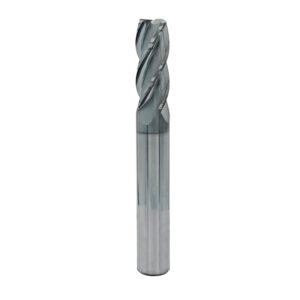When it comes to milling, precision and efficiency are paramount. Whether you are a machinist or a hobbyist, choosing the right tool can make a significant difference in the outcome of your projects. Among the wide range of milling tools available, the 4 flutes end mill ball nose stands as one of the most versatile and popular options. In this comprehensive guide, we will explore the key factors to consider when selecting the perfect 4 flutes end mill ball nose for your needs.
To achieve optimal results, it is essential to know the advantages of this tool and its ideal application areas. One of the standout features of the 4 flutes end mill ball nose is its ability to provide a smooth finish on curved surfaces. Thanks to its rounded cutting edge, it excels in contouring and shaping operations, making it ideal for tasks such as 3D machining, sculpting, and engraving. The four cutting flutes also contribute to its efficiency, allowing for faster material removal and reducing the chances of chip clogging, ultimately leading to improved productivity.
When choosing a 4 flutes end mill ball nose, several factors need to be taken into consideration. The first factor to consider is the material you will be working with. Different materials require different cutting speeds and feed rates to achieve the desired results. For softer materials like plastics and wood, a larger ball size may be suitable as it will help prevent deflection. However, for harder materials such as metals, a smaller ball size would be more effective for precise and accurate cuts.
Another critical factor is the coating of the end mill. Coatings play a vital role in enhancing the durability and performance of the tool. For example, a TiAlN (Titanium Aluminum Nitride) coating provides excellent wear resistance and heat resistance, making it suitable for high-speed machining and prolonging the tool’s lifespan. On the other hand, a TiN (Titanium Nitride) coating offers improved lubricity and reduces friction, making it ideal for cutting sticky materials.
Furthermore, consider the length and diameter of the tool. The length should be chosen based on the depth of the cuts you will be making, while the diameter will determine the tool’s ability to access tight corners and intricate details. It is crucial to strike a balance between these factors to ensure optimal performance throughout your milling operation.
Let’s consider an example to illustrate the importance of choosing the right 4 flutes end mill ball nose. Suppose you are working on a woodworking project that involves sculpting intricate designs. In such a case, a 4 flutes end mill ball nose with a larger ball size and a TiN coating would be an excellent choice. The larger ball size would help prevent deflection during the milling process, ensuring precise cuts, while the TiN coating would reduce friction and facilitate smooth operation.
In conclusion, selecting the right 4 flutes end mill ball nose can significantly impact the outcome of your milling projects. Consider factors such as material, coating, length, and diameter to ensure optimal results. Remember that different materials and applications may require specific variations of the 4 flutes end mill ball nose, so it is essential to assess your needs accurately. By taking the time to choose the right tool, you can achieve exceptional results, enhance productivity, and ultimately elevate your milling experience.

